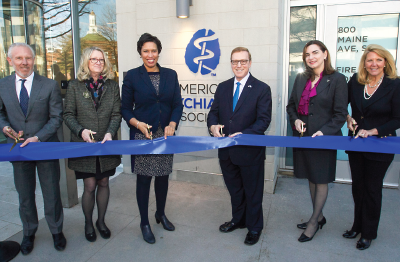APA’s New Home Reflects Its Proud Past and Vision for the Future

On March 16—a day that APA has anticipated for more than three years—we celebrated a new day and a new chapter in the 174.5 years that APA has been in existence: APA held the Grand Opening of its new headquarters in Washington, D.C. I am so proud to have been a part of the event.
More than 140 APA leaders, friends from allied mental health organizations, local dignitaries, and staff attended the Grand Opening, which consisted of a ribbon-cutting ceremony, remarks by a distinguished panel including Washington, D.C., Mayor Muriel Bowser, and tours of APA’s new offices. Many more individuals watched the livestreaming of the public events.
The jewel in the crown of our new home is the APA Library and Rare Books Room, where many historic psychiatric artifacts and books are on display or housed. Also, there is a special room designated for the use of APA members when they are in town. You are welcome to get some work done in a comfortable setting or take time out to relax and enjoy your new headquarters. (Detailed information and photos of the Grand Opening will appear in the next issue of Psychiatric News.)
When I was thinking about the remarks I wanted to make at the Grand Opening ceremony, I remembered an unexpected delight that I had experienced early in my presidency. I received a simple brown package in the mail with the return address of Princeton, N.J. It contained a book from Dr. David Nathan called Dr. Kirkbride and His Mental Hospital, an accounting of the life and work of Dr. Thomas Kirkbride. It was written by Dr. Earl E. Bond and published in 1947. Dr. Kirkbride was the superintendent of what later became known as the Institute of Pennsylvania Hospital in Philadelphia and a strong advocate of “moral treatment,” a philosophy based upon compassion and respect for people with mental illness.

Getting ready to cut the ribbon to officially open APA’s new headquarters in The Wharf district of Washington, D.C., are (from left) Monty Hoffman, CEO of PN Hoffman & Associates, one of the developers of The Wharf; APA President Anita Everett, M.D.; D.C. Mayor Muriel Bowser; APA CEO and Medical Director Saul Levin, M.D., M.P.A.; Assembly Speaker Theresa Miskimen, M.D.; and Sherry Cushman, executive managing director and leader of the Legal Sector Advisory Group at Cushman & Wakefield.
At the Grand Opening, I shared passages from this book to connect APA’s new home with our founding. Keep in mind as you read this passage that Dr. Bond’s book was published 71 years ago.
This is from Chapter 14, “The Association and Dorothea Dix, 1844”:
The year 1844 was a red-letter period for the young superintendent [Dr Kirkbride]. In the course of that year, he became closely linked in personal and professional relationships with twelve men outside of Pennsylvania who carried on the same work that absorbed him. Also, he met and began a friendship with one woman, a spinster from Boston, who did more to help the insane than any thousand men.
The men were physicians in charge of hospitals for the insane. In the deplorable conditions for these patients throughout the United States they showed what could and should be done. Their leader at this time was Dr. Samuel Woodward of Worcester, whom Kirkbride had visited in 1840 and learned to admire. This man talked to Dr. Francis Stribling of Virginia, and they both talked to Kirkbride, who, with his characteristic hospitality and his central location, invited them and ten others to his home on October 15, 1844. This historic dinner resulted in the historic “founding meeting” the next day, at Jones Hotel in Philadelphia, of the Association of Medical Superintendents of American Institutions for the Insane, which later became the American Psychiatric Association.
Bond goes on to write:
The name of the thirteen appear upon a plate of the visitor’s book which was kept at the Hospital. The date was October 17, 1844.
That date is almost exactly 174.5 years from the very day that we officially opened our new national headquarters. These 13 men were described by Albert Deutsch in Dr. Bond’s book as being “alive with energy, of great vitality, forceful will, and abounding humanity. Together they worked to formulate their specialty into an integrated whole. … They eagerly strove to collect the facts and to use them to benefit their stricken fellow men.”
Then as now, APA’s mission is to advocate for improved access to evidence-based treatment and to support the professional needs of our members. Our new headquarters is a splendid visualization of the pride we have in psychiatry and its historic place not only in American medicine but also American history. Could our 13 founding fathers even have dreamed of our monumental achievements in research, treatment, education, and advocacy?
We hope that you will consider visiting our new headquarters, located at 800 Maine Avenue in Southwest D.C. As you enter through the main entrance on the ninth floor, you will see a mural of our 13 founding fathers. Their stately faces look out onto the members lounge and, beyond that, our nation’s capitol. They would be exceptionally awed by the stature and the influence of the organization they founded 174.5 years ago. ■



